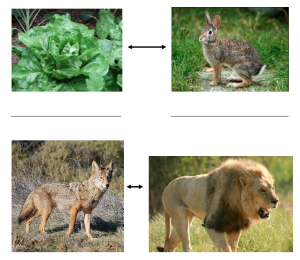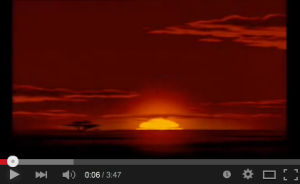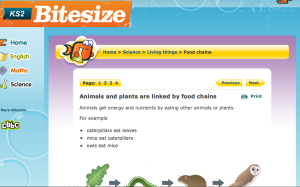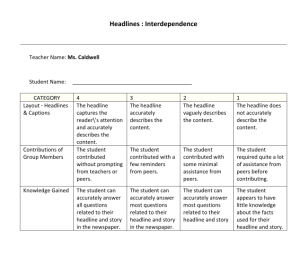Unit Objective
Students will determine that all life is interdependent and interacts with the environment.
Students will describe the characteristics of and variations between living and nonliving things.
Students will expresses knowledge of the relationships between plants, animals, and humans’ influence on the surrounding environment.
Students will analyze the impact of predation, competition, and interdependence among living things.
Students will express understanding of ecosystems by citing evidence and explaining their rationale through a written newspaper article.
Students will summarize key points by creating a relevant and encompassing thinking routine headline.
Students will share their newspaper articles and headlines with the class.
Background and Rationale
Ecosystems are important to human life. They provide a everything from clean air and water to food and fuel. Unfortunately, there is a global concern of their decline and there has become an increased awareness of the need to protect it by overcoming several challenges. Students will see the importance of exploring the interdependence of living elements such as plants, animals and humans.
The thinking routine that is being used as a culmination of the interdependence unit. It is connected to the lesson objectives by asking the students to analyze their learning over the unit and demonstrating mastery in all of the objectives. Students will use their knowledge learned from the lessons in the unit to summarize the big idea into one headline. Then, using Google Docs, students will type the rest of the story, applying evidence and information from the lesson that expresses their understanding of interdependence in nature.
Lesson Objectives
Objective |
Bloom’s Verb |
|---|---|
|
Describe the characteristics of and variations between living and nonliving things. |
Understanding |
|
Express knowledge of the relationships between plants, animals, and humans’ influence on the surrounding environment. |
Understanding |
|
Analyze the impact of predation, competition, and interdependence among living things. |
Analyzing |
| Express understanding of ecosystems by citing evidence and explaining their rationale through a written newspaper article. | Applying |
| Summarize key points by creating a relevant and encompassing thinking routine headline. | Applying |
|
Orally present newspaper articles and headlines with the class. |
Remembering |
Bloom’s Taxonomy
Applying
Common Core / State and District Standards
Standards: Science
-
GLE 0407.2.1 Analyze the effects of changes in the environment on the stability of an ecosystem.
CCSS Writing
-
CCSS.ELA-LITERACY.W.4.2 Write informative/explanatory texts to examine a topic and convey ideas and information clearly.
-
CCSS.ELA-LITERACY.W.4.6 With some guidance and support from adults, use technology, including the Internet, to produce and publish writing as well as to interact and collaborate with others; demonstrate sufficient command of keyboarding skills to type a minimum of one page in a single sitting.
Learning and Innovation Skills (P21.org)
Creativity and innovation
Think Creatively:
-
Use a wide range of idea creation techniques (such as brainstorming)
-
Create new and worthwhile ideas (both incremental and radical concepts)
-
Elaborate, refine, analyze and evaluate their own ideas in order to improve and maximize creative efforts
Work Creatively with Others:
-
Develop, implement and communicate new ideas to others effectively
-
Be open and responsive to new and diverse perspectives; incorporate group input and feedback into the work
Reason Effectively:
-
Analyze how parts of a whole interact with each other to produce overall outcomes in complex systems
Make Judgments and Decisions
-
Effectively analyze and evaluate evidence, arguments, claims and beliefs
-
Analyze and evaluate major alternative points of view
-
Reflect critically on learning experiences and processes
Communicate Clearly
-
Articulate thoughts and ideas effectively using oral, written and nonverbal communication skills in a variety of forms and contexts
Collaborate with Others
-
Demonstrate ability to work effectively and respectfully with diverse teams
Life and Career Skills (P21.org)
Flexibility and Adaptability: Be Flexible
-
Incorporate feedback effectively
-
Deal positively with praise, setbacks and criticism
Initiative and Self Direction: Work Independently
-
Monitor, define, prioritize and complete tasks without direct oversight
Productivity and Accountability: Produce Results
-
Multi-task
-
Participate actively, as well as be reliable and punctual
-
Present oneself professionally and with proper etiquette
-
Collaborate and cooperate effectively with teams
-
Respect and appreciate team diversity
-
Be accountable for results
Information, Media, and Technology Skills (P21.org)
Create Media Products
-
Understand and utilize the most appropriate media creation tools, characteristics and conventions
Apply Technology Effectively
-
Use technology as a tool to research, organize, evaluate and communicate information
-
Use digital technologies (computers, PDAs, media players, GPS, etc.), communication/networking tools and social networks appropriately to access, manage, integrate, evaluate and create information to successfully function in a knowledge economy
Lesson – Introduction
Begin the lesson by having the students listen to song “The Circle of Life” from the Lion King movie.
Lesson Activities and Procedures
Student Procedure |
Teacher Procedure |
Materials |
|---|---|---|
| The student will recall what they have learned about the food chain. | The teacher will review and discuss food chains from the previous lesson. | |
| The student will brainstorm what they know about a food web and share it with the class. | The teacher will share that most living things are part of more than one food chain. Additionally, the many food chains in an area are combined, or linked, for a web. | |
| The teacher will provide examples of food chains from animals studied, showing how animals can be prey for various predators. | Examples of food chains | |
| The students will organize pictures into what they believe to be the circle of life. | The teacher will pose the question of what would happen if part of a food chain disappeared as picture cards are shared of lettuce, rabbit, coyote, and lion |  |
| The students will navigate through a tutorial about a food chain, producers & consumers as well as prey & predators. | The teacher will guide the students through a navigation of the tutorial on the food chain, producers & consumers as well as prey & predators. | |
| The students will answer questions about what they learned from the tutorial. | The teacher will ask the following questions:
Answers:
|
 |
| The student will classify the pictures as a producer or consumer, predator or prey. | The teacher will have the students to use a template to write a newspaper article about what they have learned about food chains. | |
| The student will use a thinking routine known as a headline to capture the big idea of the lesson. | The teacher will request a catchy headline for the news article. | headline |
Lesson Closure
Each student pair will write an independently written story in Google Docs using the provided newspaper template. Students must type their story and add images with captions. Since each pair has the same headline, but a different story, they will enter their information in their assigned section of the article. Additionally, since Google Docs is the platform, students can work simultaneously. Partnered students must also collaborate on the fonts, newspaper name, and other common features of the newspaper.
References:
Youtube – Lion King “The Circle of Life” song





